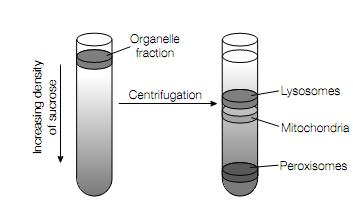Equilibrium Density-Gradient Centrifugation
Equilibrium density-gradient centrifugation is frequently used to further purify organelles following their partial separation by differential velocity centrifugation. In this process the organelles are separated on the basis of their density, not their size. At the top of a centrifuge tube the impure organelle fraction is loaded that contains a gradient of a dense solution (for example. a sucrose solution ;). The sucrose solution is most concentrated (dense) at the bottom of the tube, and decreases in density (and concentration) towards the top of the tube. The various organelles move down the tube to an equilibrium position during centrifugation (For instance 160 000g for 3 h) where their density is equal to that of the sucrose at that position. Forces of sedimentation tend to make the organelles move further down the tube but, they enter a region of higher density, if they do so.

Separation of organelles by equilibrium density-gradient centrifugation
than the organelle density and so they float back to their earlier position. Lysosomes , Mitochondria and peroxisomes all differ in density and so can be separated effectively from one another by density-gradient centrifugation. In the same manner, the rough endoplasmic reticulum, plasma membrane and Golgi apparatus can be separated by using a gradient of lower density. To make the density gradient the more dense cesium chloride is utilized for the separation of denser particles such as RNA , DNA and proteins by equilibrium centrifugation.